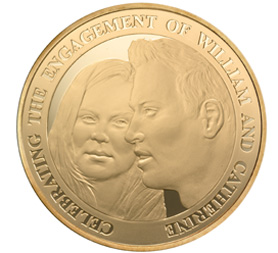William and Kate engagement coin unveiled
The Royal Mint releases a coin for Prince William and Kate Middleton’s engagement – but the likenesses are somewhat dubious. An artist tells Channel 4 News a “warts and all” portrait is not the point.

The happy royal couple, due to wed in April next year, have been featured on a £5 commemorative coin produced by the Royal Mint.
The design shows Prince William in profile, and his bride-to-be Kate Middleton face on – but she appears older, and heavier set, in the portrait than she does in real life.
The coin was designed by the Royal Mint’s in-house engraving team and is the first ever royal engagement coin to be produced. It can be ordered online for between £9.99 and up to £1,550 for a gold version.
A Royal Mint spokesman said: “The inspiration for the design came from photographs of the couple at a sporting event – the play on the traditional portrait is that Prince William is seen in profile, alluding to his royal status.”
You don’t want warts and all…But the idealisation has to be work of art, like the portrait of the young Queen. Artist Christopher Le Brun
When asked about Miss Middleton’s likeness, a spokesman stressed that the design “does go though a rigorous approval process”. Both the Queen and Prince William approved the coin.
Channel 4 News spoke to Christopher Le Brun RA, an artist who has produced several designs for commemorative coins, including a 50p marking Kew Gardens’ 250th anniversary last year.
He said the coin making process was unlikely to be to blame for questions over the likeness to Kate.
“I don’t think the artist can blame the coin making process,” he said.
“But then portraiture in low-relief is extremely difficult, particularly if taken from a photograph. The photograph is already an interpretation of the subject, so the portrait has less chance of success.
“The portrait of the Queen when she was young – that is an extremely elegant and beautiful portrait. The current representation is more problematic, because she should appear as the sovereign, not a lady of a certain age. Representing her as a person is less suitable for a coin or a medal.
“With this coin – is it a portrait of two people, or is it the heir to the throne? You don’t want warts and all. Informality and coinage don’t in my view go well together. But the idealisation has to be a work of art – like the portrait of the young Queen.”
The process of making a coin
Artist Christopher Le Brun explains to Channel 4 News the process of designing and making a coin.
"You do a drawing, and then there's normally a competition with up to six artists submitting designs to the Royal Mint advisory committee. They select a couple to go forward and then the drawing is turned into a 3D model, usually in plaster.
"Modifications at that point are suggested by the committee – there’s to-ing and fro-ing between the artist and the committee, which is made up of historians, people from the art world, coin specialists.
"Then if it gets approval, it is reduced to miniature proportions by the Royal Mint technical people, then it's turned into a coin.
"It is after the first stage that the difficult bit comes – turning the design into a low-relief 3D model. It is technically very demanding, so occasionally the artist does not do it, a specialist does it, and they interpret your design. It is up to the artist to guide them and keep the spirit of it."